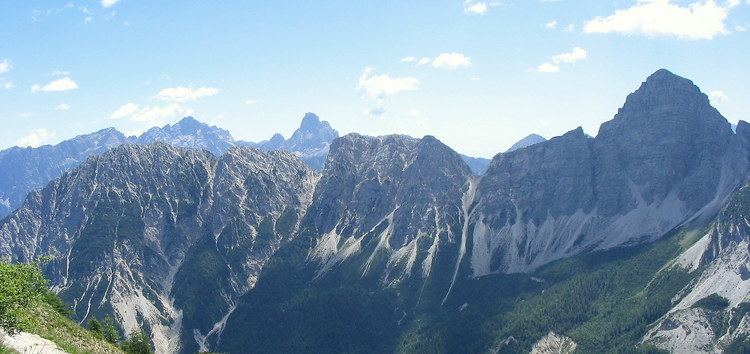Peak Marmolada Parent range Alps Age of rock Mostly Triassic Highest point Marmolada Province Province of Belluno | Country Italy Orogeny Alpine orogeny Elevation 3,343 m Mountain range Alps | |
 | ||
Type of rock Sedimentary rocks,
including dolomite, and volcanics Passes Pordoi Pass, Sella Pass, Gardena Pass, Falzarego Pass Mountains Marmolada, Kronplatz, Latemar, Langkofel, Monte Civetta Similar Marmolada, Tre Cime di Lavaredo, Kronplatz, Cinque Torri, Langkofel | ||
Breathtaking hike in the dolomites eurotrip 6
The Dolomites (Italian: Dolomiti [doloˈmiːti]; Ladin: Dolomites; German: Dolomiten [doːloːˈmɪtn̩]; Venetian: Dołomiti [doɰoˈmiti]: Friulian: Dolomitis) are a mountain range located in northeastern Italy. They form a part of the Southern Limestone Alps and extend from the River Adige in the west to the Piave Valley (Pieve di Cadore) in the east. The northern and southern borders are defined by the Puster Valley and the Sugana Valley (Italian: Valsugana). The Dolomites are nearly equally shared between the provinces of Belluno, South Tyrol and Trentino.
Contents
- Breathtaking hike in the dolomites eurotrip 6
- Map of Dolomites 32020 Rocca Pietore Province of Belluno Italy
- Flying on the dolomites 4k video 3 zinnen 2 45
- EtymologyEdit
- HistoryEdit
- GeographyEdit
- Current classificationEdit
- TourismEdit
- References
Map of Dolomites, 32020 Rocca Pietore, Province of Belluno, Italy
There are also mountain groups of similar geological structure that spread over the River Piave to the east – Dolomiti d'Oltrepiave; and far away over the Adige River to the west – Dolomiti di Brenta (Western Dolomites). There is also another smaller group called Piccole Dolomiti (Little Dolomites) located between the provinces of Trentino, Verona and Vicenza (see map).
One national park and many other regional parks are located in the Dolomites. In August 2009, the Dolomites were declared a UNESCO World Heritage Site.
Flying on the dolomites 4k video 3 zinnen 2 45
EtymologyEdit
The Dolomites, also known as the "Pale Mountains", take their name from the carbonate rock dolomite, itself named for 18th-century French mineralogist Déodat Gratet de Dolomieu (1750–1801), who was the first to describe the mineral.
HistoryEdit
During the First World War, the front line between the Italian and Austro-Hungarian forces ran through the Dolomites and there was fierce mine warfare.
There are now open-air war museums at Cinque Torri (Five Towers) and Mount Lagazuoi. Many people visit the Dolomites to climb the vie ferrate, protected paths created during the First World War.
A number of long distance footpaths run across the Dolomites, which are called "alte vie" (i.e., high paths). Such long trails, which are numbered from 1 to 8, require at least a week to be walked through and are served by numerous "Rifugi" (huts). The first and, perhaps, most renowned is the Alta Via 1.
Radiocarbon dating has been used in the Alta Badia region to draw a connection between landslide movement and climate change. The layering of rocks and organic matter make for a rich trove of material that can used to perform these scientific investigations. Landslides are caused by natural processes, most notably the humidity of soil, which is a direct result of the climate.
GeographyEdit
The region is commonly divided into the Western and Eastern Dolomites, separated by a line following the Val Badia – Campolongo Pass – Cordevole Valley (Agordino) axis.
Current classificationEdit
The Dolomites may be divided into the following ranges:
TourismEdit
The Dolomites are renowned for skiing in the winter months and mountain climbing, hiking, cycling, and BASE jumping, as well as paragliding and hang gliding in summer and late spring/early autumn. Free climbing has been a tradition in the Dolomites since 1887, when 17-year-old Georg Winkler soloed the first ascent of the pinnacle Die Vajolettürme. The main centres include: Rocca Pietore alongside the Marmolada Glacier, which lies on the border of Trentino and Veneto, the small towns of Alleghe, Falcade, Auronzo, Cortina d'Ampezzo and the villages of Arabba, Urtijëi and San Martino di Castrozza, as well as the whole of the Fassa, Gardena and Badia valleys.
The Maratona dles Dolomites, an annual single-day road bicycle racing race covering seven mountain passes of the Dolomites, occurs in the first week of July.
Other characteristic places are:
